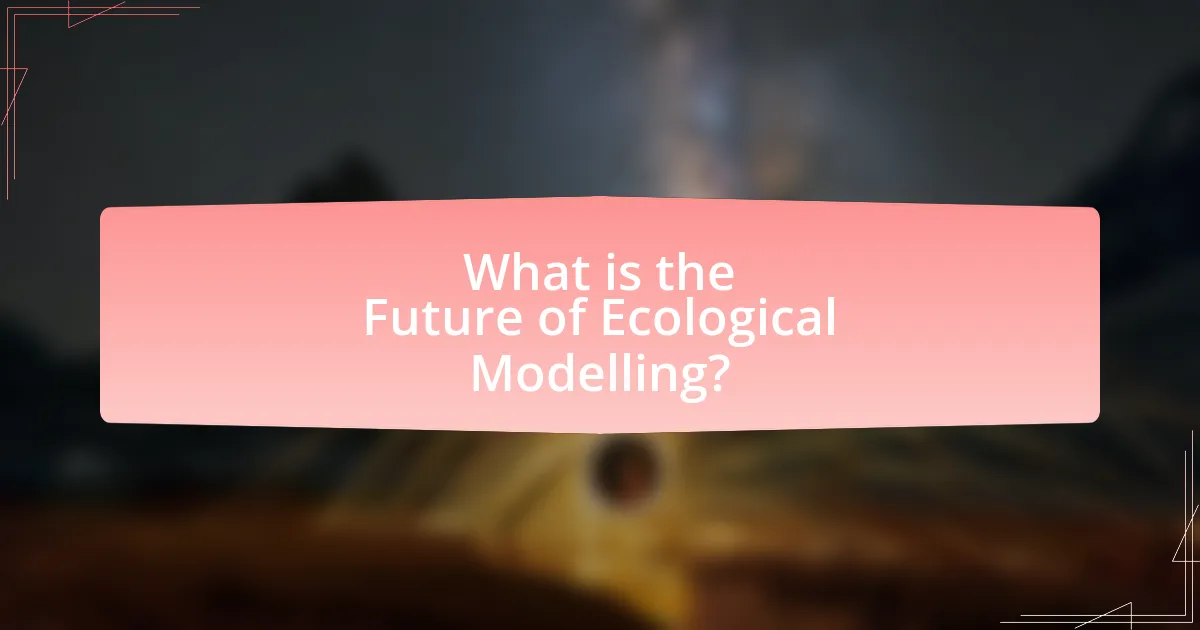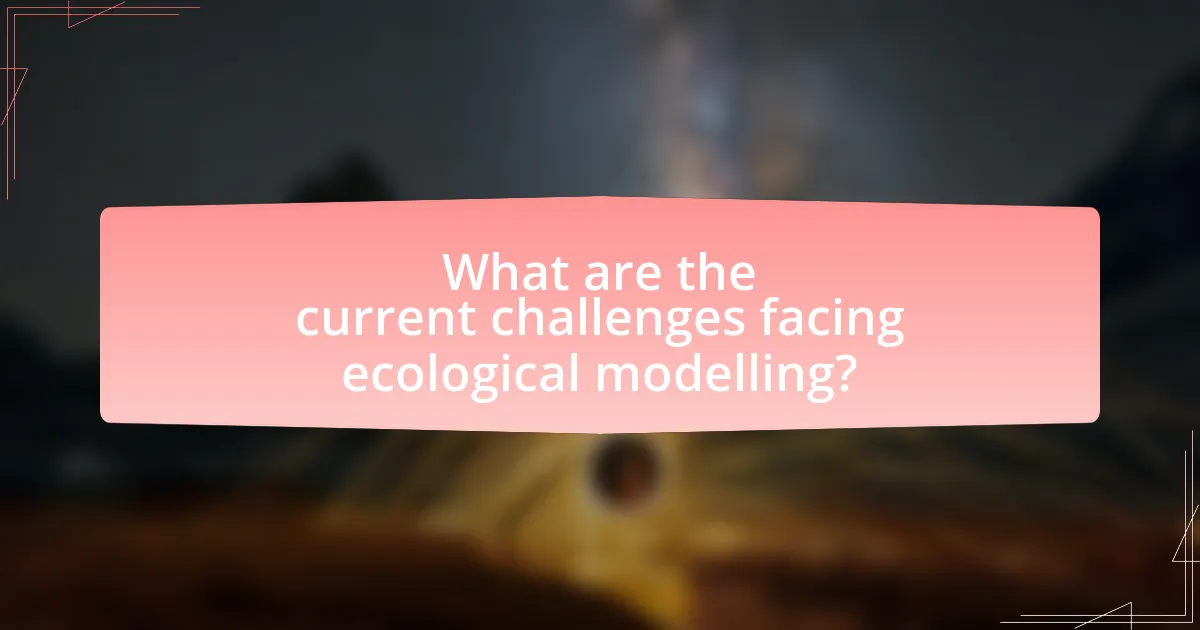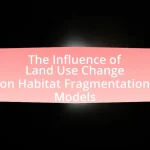The article focuses on the future of ecological modelling, emphasizing the integration of advanced computational techniques and big data analytics to improve predictive capabilities and decision-making in environmental science. It outlines the definition and evolution of ecological modelling, highlighting key components such as data collection, model formulation, and validation. The article also addresses the importance of ecological modelling in biodiversity conservation and climate change research, while discussing current challenges like data scarcity and model complexity. Additionally, it explores the role of technological advancements, interdisciplinary approaches, and stakeholder engagement in enhancing ecological modelling efforts, ultimately identifying emerging trends and best practices for effective application in addressing environmental challenges.

What is the Future of Ecological Modelling?
The future of ecological modelling is increasingly focused on integrating advanced computational techniques and big data analytics to enhance predictive capabilities and decision-making processes. As environmental challenges intensify due to climate change and biodiversity loss, ecological models will evolve to incorporate real-time data from sources such as remote sensing and citizen science, allowing for more dynamic and responsive management strategies. Research indicates that the application of machine learning and artificial intelligence in ecological modelling can significantly improve the accuracy of predictions, as evidenced by studies like “Machine Learning for Ecological Modelling” published in the journal Ecological Modelling, which highlights the potential of these technologies to analyze complex ecological interactions more effectively.
How is ecological modelling defined in contemporary research?
Ecological modelling in contemporary research is defined as the use of mathematical and computational techniques to simulate ecological processes and predict the dynamics of ecosystems. This definition encompasses various approaches, including statistical models, mechanistic models, and agent-based models, which are employed to understand complex interactions within ecological systems. The validity of this definition is supported by the increasing reliance on ecological models in studies addressing climate change impacts, species distribution, and ecosystem management, as evidenced by research published in journals such as “Ecological Modelling” and “Journal of Applied Ecology.”
What are the key components of ecological modelling?
The key components of ecological modelling include conceptual frameworks, data collection, model formulation, validation, and application. Conceptual frameworks provide the foundational understanding of ecological processes and relationships, guiding the development of models. Data collection involves gathering relevant ecological data, which is essential for accurate model representation. Model formulation translates ecological theories into mathematical or computational representations, allowing for simulations of ecological dynamics. Validation ensures that models accurately reflect real-world conditions through comparison with empirical data. Finally, application involves using models to inform decision-making, policy development, and management strategies in ecology. These components are critical for creating effective ecological models that can address complex environmental challenges.
How has the definition of ecological modelling evolved over time?
The definition of ecological modelling has evolved from simple representations of ecological systems to complex, dynamic frameworks that incorporate uncertainty and adaptive management. Initially, ecological models focused on static relationships among species and their environments, primarily using linear equations to describe interactions. Over time, advancements in computational power and data availability have allowed for the development of more sophisticated models, such as agent-based and spatially explicit models, which account for the complexities of ecosystems and human impacts. This evolution reflects a growing recognition of the need for models to be flexible and responsive to changing ecological conditions, as highlighted by the increasing emphasis on scenario analysis and predictive capabilities in contemporary ecological research.
Why is ecological modelling important for environmental science?
Ecological modelling is important for environmental science because it provides a systematic approach to understanding complex ecological systems and predicting their responses to various environmental changes. By simulating interactions among biotic and abiotic factors, ecological models help scientists assess the impacts of climate change, habitat loss, and pollution on ecosystems. For instance, models like the Integrated Assessment Models (IAMs) have been used to evaluate the effects of different climate policies on biodiversity and ecosystem services, demonstrating their utility in informing conservation strategies and policy decisions.
What role does ecological modelling play in biodiversity conservation?
Ecological modelling plays a crucial role in biodiversity conservation by providing frameworks to simulate and predict the impacts of environmental changes on ecosystems. These models help conservationists understand species interactions, habitat requirements, and the effects of climate change, enabling informed decision-making for conservation strategies. For instance, studies have shown that models can predict species distribution shifts due to climate change, allowing for proactive measures to protect vulnerable species and habitats. By integrating data from various sources, ecological models enhance the effectiveness of conservation efforts and contribute to sustainable management practices.
How does ecological modelling contribute to climate change research?
Ecological modelling significantly contributes to climate change research by providing frameworks to simulate and predict the impacts of climate variables on ecosystems. These models integrate data on species interactions, habitat changes, and climate scenarios, allowing researchers to assess potential outcomes of climate change on biodiversity and ecosystem services. For instance, studies have shown that ecological models can predict shifts in species distributions due to temperature increases, helping to identify vulnerable species and prioritize conservation efforts. Additionally, models like the Integrated Assessment Models (IAMs) are used to evaluate the effectiveness of different climate mitigation strategies, demonstrating their critical role in informing policy decisions.

What are the current challenges facing ecological modelling?
Current challenges facing ecological modelling include data scarcity, model complexity, and uncertainty in predictions. Data scarcity arises from limited availability of high-quality ecological data, which hampers model accuracy. Model complexity is a challenge as ecological systems are inherently intricate, making it difficult to create models that adequately capture all relevant interactions and processes. Additionally, uncertainty in predictions stems from the variability in ecological responses to environmental changes, which complicates the ability to make reliable forecasts. These challenges are critical as they directly impact the effectiveness of ecological models in informing conservation and management strategies.
What limitations exist in current ecological modelling techniques?
Current ecological modelling techniques face several limitations, including data scarcity, oversimplification of complex systems, and challenges in accurately predicting ecological responses to environmental changes. Data scarcity arises from insufficient or low-quality data, which hampers model accuracy and reliability. Oversimplification occurs when models fail to capture the intricate interactions within ecosystems, leading to incomplete or misleading results. Additionally, predicting ecological responses is complicated by the dynamic nature of ecosystems and the influence of multiple, often unpredictable, factors such as climate change and human activities. These limitations highlight the need for improved data collection methods and more sophisticated modelling approaches to enhance ecological understanding and management.
How do data availability and quality impact ecological models?
Data availability and quality significantly impact ecological models by determining their accuracy and reliability. High-quality, abundant data allows for more precise parameterization of models, leading to better predictions of ecological dynamics. For instance, models that utilize comprehensive datasets, such as those from long-term ecological research sites, can more effectively capture species interactions and environmental changes. Conversely, limited or poor-quality data can result in biased outcomes, as seen in studies where inadequate sampling led to erroneous conclusions about species distributions. Therefore, the integrity of ecological models is directly linked to the availability and quality of the underlying data.
What are the challenges of integrating multiple ecological variables?
Integrating multiple ecological variables presents challenges such as data heterogeneity, complexity in interactions, and scale mismatches. Data heterogeneity arises from variations in data types, sources, and collection methods, making it difficult to create a unified model. The complexity in interactions among variables can lead to non-linear relationships that are hard to quantify and predict. Additionally, scale mismatches occur when ecological processes operate at different spatial and temporal scales, complicating the integration of data from various sources. These challenges hinder the development of accurate ecological models, as evidenced by studies indicating that models incorporating diverse variables often struggle to achieve reliable predictions due to these integration issues.
How do technological advancements affect ecological modelling?
Technological advancements significantly enhance ecological modelling by improving data collection, analysis, and simulation capabilities. Innovations such as remote sensing, machine learning, and high-performance computing enable researchers to gather vast amounts of ecological data more efficiently and analyze complex interactions within ecosystems. For instance, remote sensing technologies allow for real-time monitoring of environmental changes, while machine learning algorithms can identify patterns and predict ecological outcomes with greater accuracy. These advancements lead to more robust models that can inform conservation strategies and policy decisions, ultimately contributing to better management of natural resources.
What role do machine learning and AI play in enhancing ecological models?
Machine learning and AI significantly enhance ecological models by improving data analysis, predictive accuracy, and model adaptability. These technologies enable the processing of large datasets, such as satellite imagery and sensor data, allowing for more precise modeling of ecological systems. For instance, machine learning algorithms can identify patterns in species distribution and habitat changes, which traditional models may overlook. Research published in “Ecological Modelling” by McCarthy et al. (2020) demonstrates that AI-driven models can predict ecological outcomes with up to 30% greater accuracy compared to conventional methods. This advancement facilitates better decision-making in conservation and resource management, ultimately leading to more effective ecological interventions.
How can remote sensing improve data collection for ecological modelling?
Remote sensing enhances data collection for ecological modeling by providing high-resolution, spatially explicit information about environmental variables. This technology allows for the continuous monitoring of ecosystems, capturing data on vegetation cover, land use changes, and climate variables over large areas and time scales. For instance, satellite imagery can detect changes in forest cover, enabling researchers to model carbon storage and biodiversity impacts accurately. Studies have shown that integrating remote sensing data with ground-based observations improves the precision of ecological models, as evidenced by research published in “Remote Sensing of Environment” by Turner et al. (2015), which highlights the effectiveness of remote sensing in mapping habitat types and assessing ecosystem health.

What opportunities lie ahead for ecological modelling?
Ecological modelling has significant opportunities ahead, particularly in enhancing predictive capabilities for climate change impacts and biodiversity conservation. Advances in computational power and data availability enable more complex models that can simulate ecological interactions and predict outcomes under various scenarios. For instance, the integration of machine learning techniques into ecological modelling allows for improved accuracy in species distribution predictions, as demonstrated by studies like “Machine Learning for Ecological Modelling” published in the journal Ecological Applications, which highlights the effectiveness of these methods in analyzing large datasets. Additionally, collaborative platforms for data sharing among researchers can foster innovation and accelerate the development of models that address pressing environmental issues.
How can interdisciplinary approaches enhance ecological modelling?
Interdisciplinary approaches enhance ecological modelling by integrating diverse scientific perspectives, methodologies, and data sources, leading to more comprehensive and accurate models. For instance, combining insights from ecology, economics, sociology, and data science allows for a holistic understanding of ecosystems and human impacts. Research shows that models incorporating socio-economic factors can better predict the outcomes of environmental policies, as demonstrated in the study “Integrating Social and Ecological Models for Ecosystem Management” by Levin et al. (2017), published in the journal Ecosystem Services. This integration not only improves predictive accuracy but also fosters collaboration among scientists, policymakers, and stakeholders, ultimately leading to more effective conservation strategies.
What benefits arise from collaboration between ecologists and data scientists?
Collaboration between ecologists and data scientists enhances ecological research through improved data analysis, modeling accuracy, and predictive capabilities. Ecologists provide domain-specific knowledge, while data scientists contribute advanced analytical techniques and computational tools. This synergy enables the development of more robust ecological models, as evidenced by studies showing that integrating machine learning with ecological data can lead to significant improvements in species distribution predictions, with accuracy increases of up to 30% in some cases. Furthermore, collaborative efforts facilitate the handling of large datasets, allowing for more comprehensive analyses that can inform conservation strategies and policy decisions.
How can citizen science contribute to ecological modelling efforts?
Citizen science can significantly enhance ecological modeling efforts by providing large volumes of data collected from diverse geographic locations and varying conditions. This grassroots approach allows researchers to gather real-time observations on species distribution, environmental changes, and ecological interactions, which are crucial for developing accurate models. For instance, projects like eBird have amassed millions of bird observations from volunteers, enabling researchers to analyze avian population trends and habitat use effectively. Such extensive datasets improve model calibration and validation, leading to more reliable predictions about ecological dynamics and informing conservation strategies.
What emerging trends are shaping the future of ecological modelling?
Emerging trends shaping the future of ecological modelling include the integration of machine learning, the use of big data analytics, and the incorporation of participatory approaches. Machine learning enhances predictive capabilities by analyzing complex ecological data patterns, as evidenced by studies demonstrating improved species distribution models through these techniques. Big data analytics allows for the processing of vast datasets from sources like remote sensing and citizen science, facilitating more accurate and comprehensive ecological assessments. Participatory approaches engage stakeholders in the modelling process, ensuring that local knowledge and values are incorporated, which has been shown to improve the relevance and applicability of ecological models in real-world scenarios.
How is the integration of big data transforming ecological modelling?
The integration of big data is transforming ecological modelling by enhancing the accuracy and scalability of models used to predict ecological outcomes. Big data allows for the incorporation of vast amounts of environmental, biological, and geographical information, which improves the understanding of complex ecological interactions. For instance, the use of satellite imagery and sensor data enables real-time monitoring of ecosystems, leading to more precise predictions of species distribution and habitat changes. Research has shown that models utilizing big data can achieve up to 30% higher predictive accuracy compared to traditional methods, as evidenced by studies published in journals like “Ecological Applications.” This transformation is crucial for effective conservation strategies and resource management in the face of climate change and biodiversity loss.
What potential does real-time data analysis hold for ecological modelling?
Real-time data analysis holds significant potential for ecological modeling by enabling immediate insights into ecosystem dynamics and facilitating adaptive management strategies. This capability allows researchers to monitor environmental changes, species interactions, and habitat conditions as they occur, leading to more accurate and timely predictions. For instance, studies have shown that integrating real-time satellite data with ecological models can enhance the understanding of land-use changes and their impacts on biodiversity, as demonstrated in research published in “Ecological Applications” by Turner et al. (2015). This integration supports proactive decision-making in conservation efforts, ultimately improving the resilience of ecosystems in the face of rapid environmental changes.
What best practices should be adopted for effective ecological modelling?
Effective ecological modelling should adopt best practices such as incorporating interdisciplinary approaches, utilizing robust data collection methods, and ensuring model validation and calibration. Interdisciplinary approaches enhance the understanding of complex ecological systems by integrating knowledge from various fields, such as biology, geography, and environmental science. Robust data collection methods, including remote sensing and field surveys, provide accurate and comprehensive datasets essential for model accuracy. Model validation and calibration are critical for ensuring that the model accurately represents real-world conditions, which can be achieved through techniques like cross-validation and sensitivity analysis. These practices are supported by studies indicating that models incorporating diverse data sources and rigorous validation processes yield more reliable predictions, as seen in the work of McCarthy et al. (2010) in “Ecological Modelling.”
How can researchers ensure the reproducibility of ecological models?
Researchers can ensure the reproducibility of ecological models by providing comprehensive documentation of their methodologies, data sources, and model parameters. This includes sharing code, data sets, and detailed descriptions of the modeling process, which allows other researchers to replicate the study under the same conditions. A study published in “Ecological Modelling” by McGowan et al. (2019) emphasizes that transparency in model development and validation is crucial for reproducibility. Furthermore, utilizing standardized protocols and open-source software can facilitate easier access and verification of ecological models, thereby enhancing reproducibility across different research teams.
What strategies can be employed to improve stakeholder engagement in ecological modelling?
To improve stakeholder engagement in ecological modelling, strategies such as participatory approaches, effective communication, and capacity building can be employed. Participatory approaches involve stakeholders in the modelling process, ensuring their insights and concerns are integrated, which enhances ownership and relevance of the models. Effective communication, including the use of visual aids and clear language, helps convey complex ecological concepts, making them accessible to non-experts. Capacity building through training workshops equips stakeholders with the necessary skills to engage meaningfully in the modelling process. Research indicates that these strategies lead to increased stakeholder satisfaction and better decision-making outcomes, as evidenced by case studies in community-based resource management.


